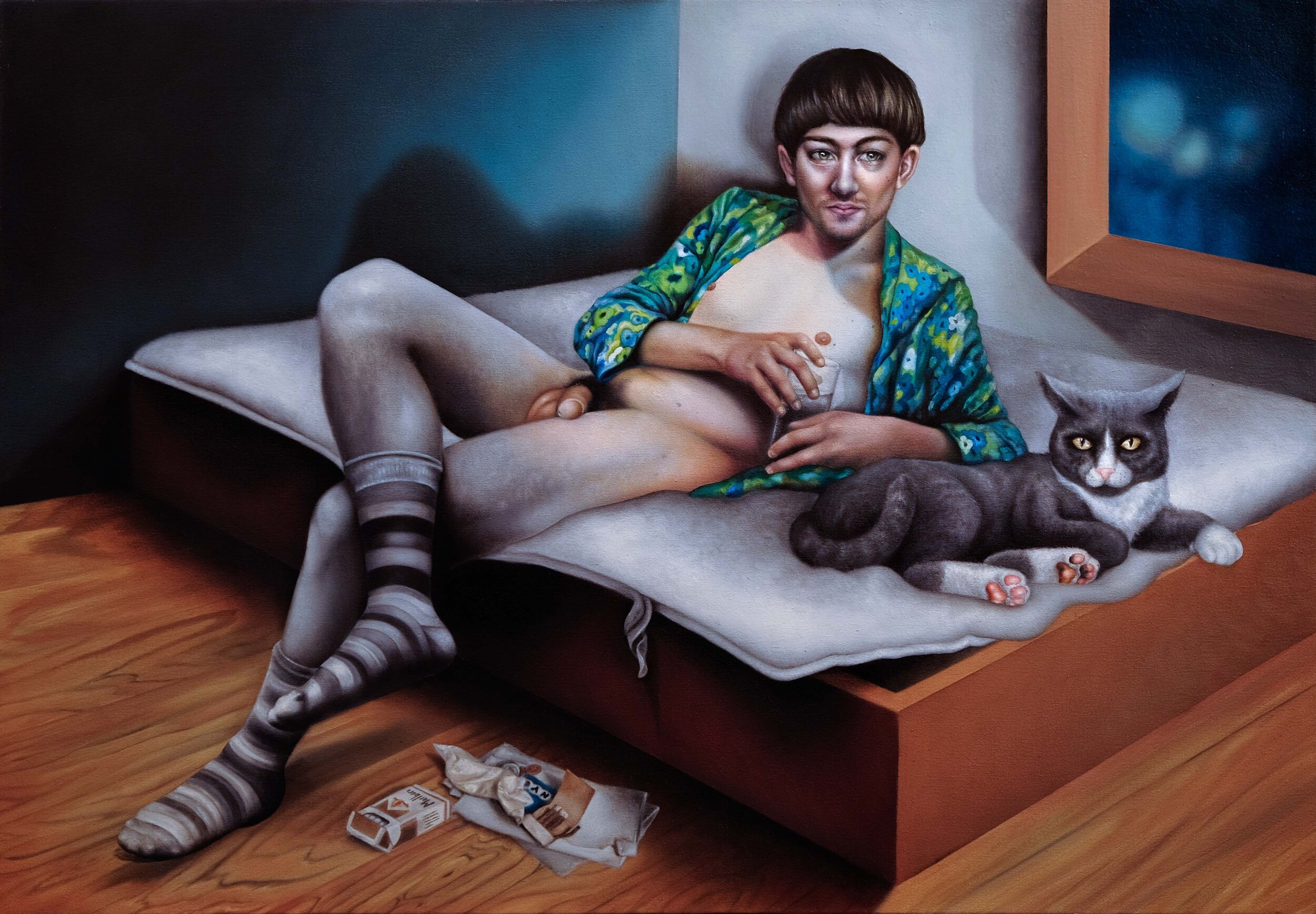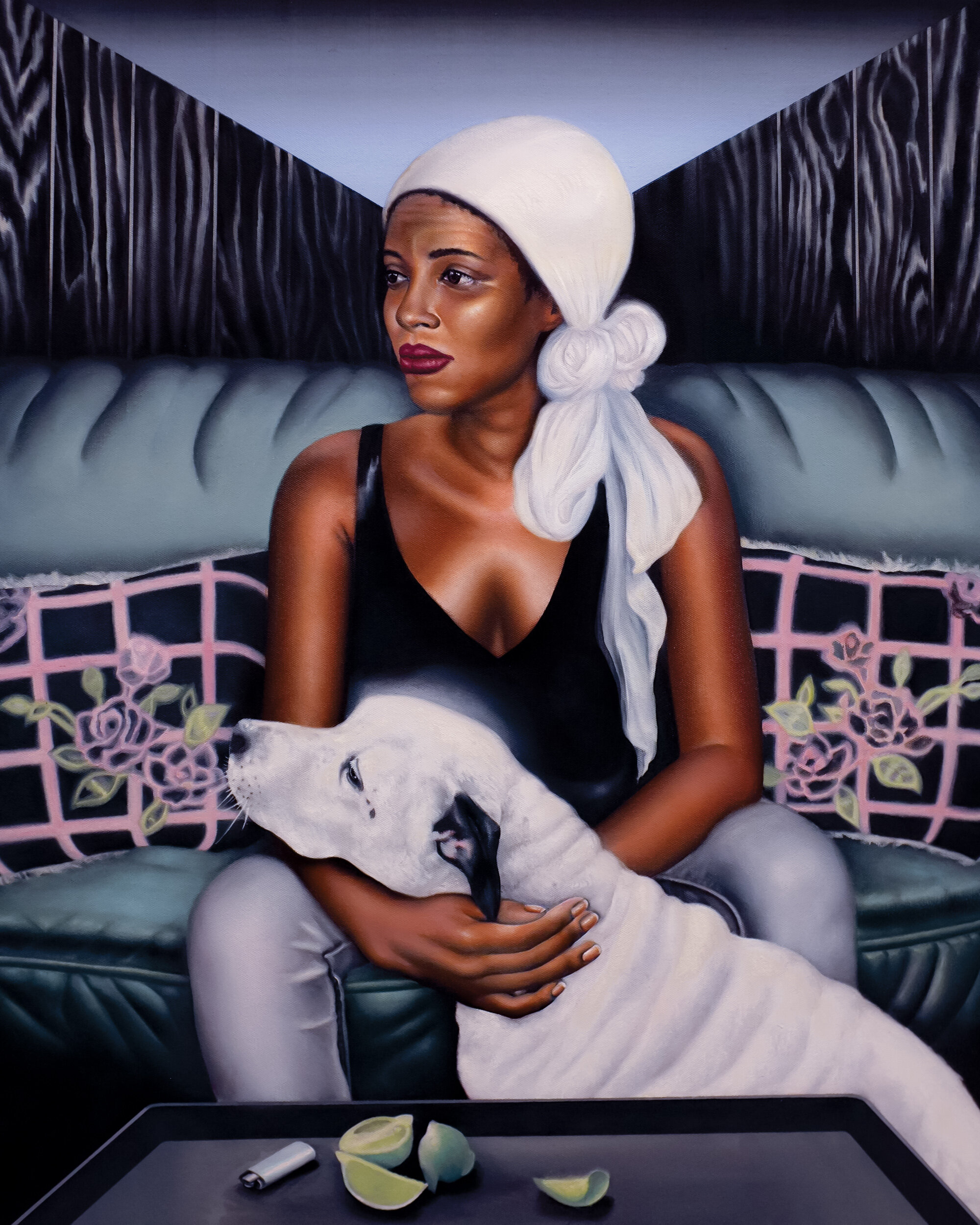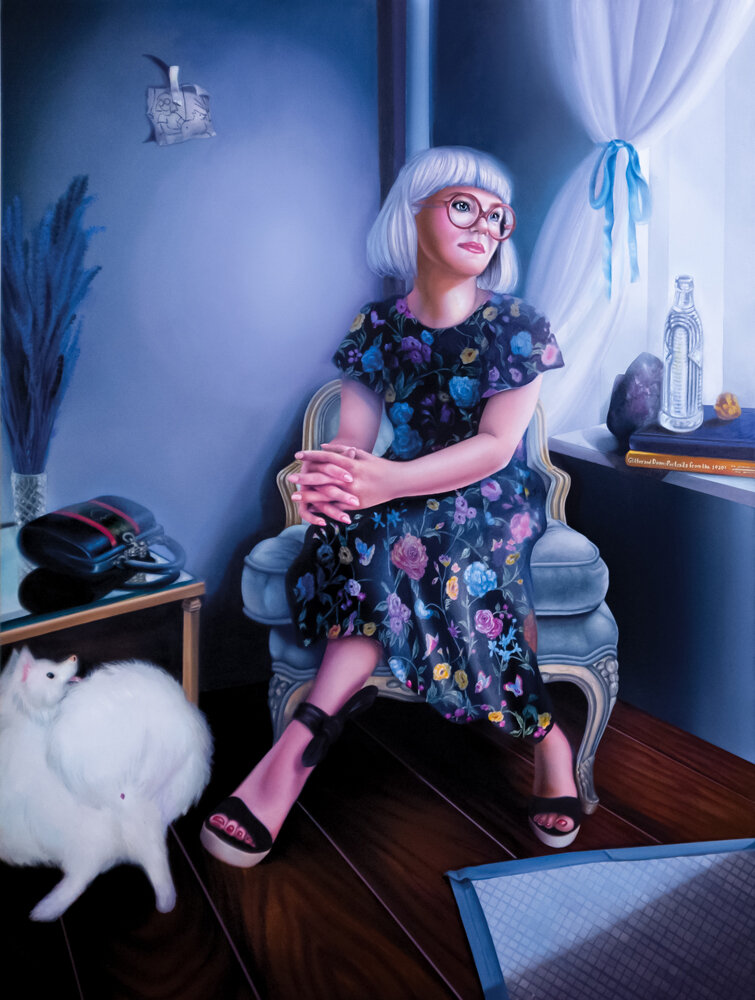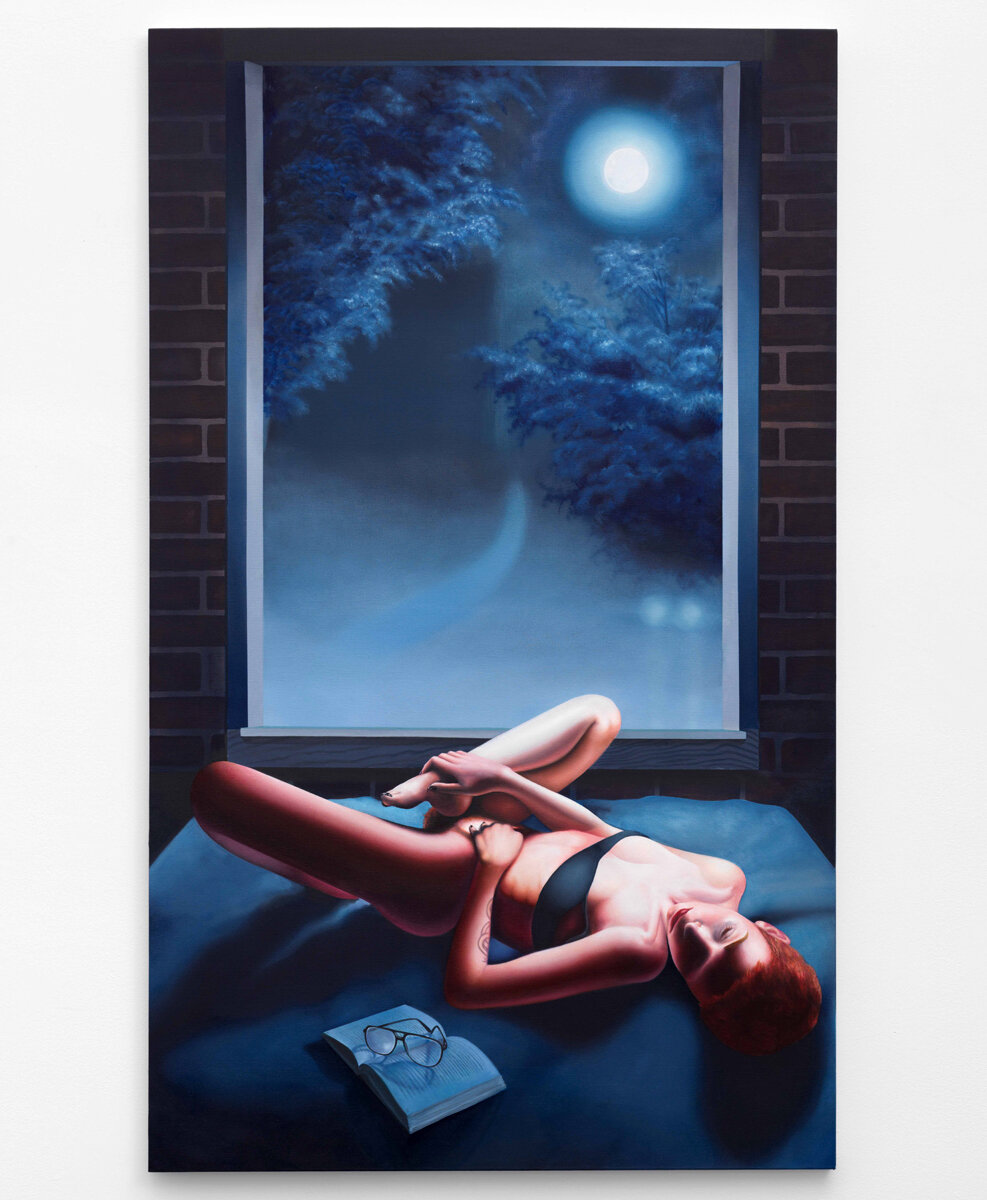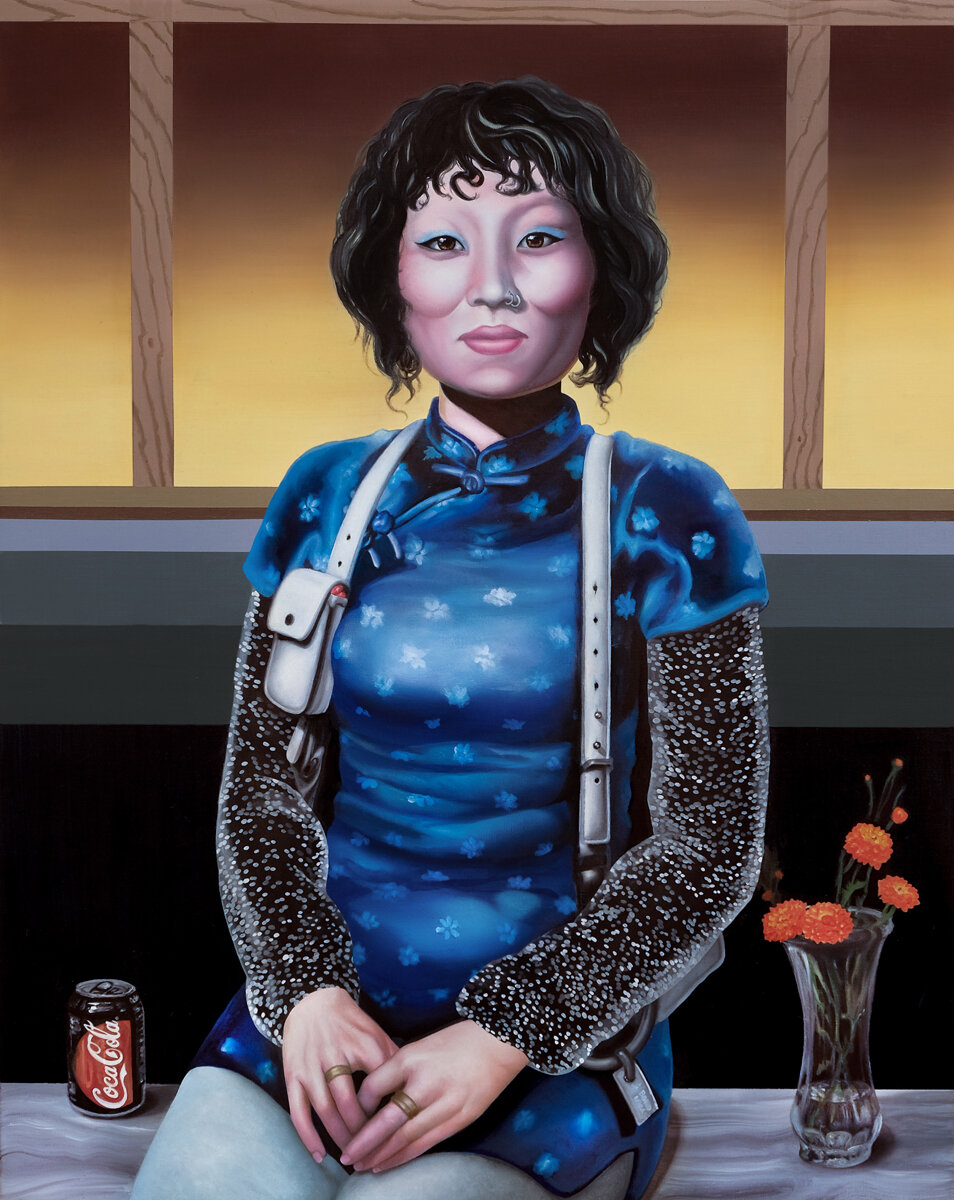Alannah Farrell
Thank you to Alannah Farrell for this lovely interview, which is hopefully the beginning of a long series of investigations into the studio practice of contemporary artists. Alannah Farrell (b.1988, Kingston, NY) lives and works in the East Village, New York, NY. They hold a BFA from The Cooper Union, New York, NY. Their work was previously exhibited at The Painting Center, New York, NY (solo); Thierry Goldberg Gallery, New York, NY; Ghost Gallery, Brooklyn, NY; and Brilliant Champions, Brooklyn, NY, among others.
Alannah Farrell in their studio
LS: Let's dive in with a tough one about your motivations as an artist. What compelled you to take this path in the beginning? Over time, how has your definition of why you're an artist has developed?
AF: Yes! That is a tricky opening question. My beginning, you might say, had all the right ingredients for a visual artist. I was brought up in a bucolic hamlet in upstate NY, cast in the shadow of a rocky household, raised by two outside-the-system artists as parents. So initially, I was guided into drawing and painting from a very young age. My early paintings access a broader and brushier palette, which seems like a world away from my process now! But, even as a child and young adult, I found painting to supply a safe space for me to grow and explore mentally.
Over time my technique and hand have shifted towards implementing more of a linear and photographic gesture. Within the past five years, my themes have become increasingly more personal as I continue diving deeper into my process!
LS: Your paintings simultaneously have a photographic and painterly quality. The verisimilitude is broken most sincerely by palette, which sets a surreal and soft tone. What prompted your transition from photography to painting?
AF: That is an excellent observation! Although I did switch to photography while attending Cooper Union for undergrad, I began with painting. My mother is a painter, and I've been drawing/painting for three decades, haha. My time studying analogue photography was an invaluable lesson in light and contrast. There are many points to draw from in the photographic process itself. My decision to return to painting after undergrad came down to the lack of direct action in photography (the hand) and a loss of identity I felt whenever paint wasn't my sole/primary medium. Ultimately, I took my curiosity with the camera as far as it would go for my artistic vision.
LS: What have you learned in the process? About making art and about yourself?
AF: Oof, there is so much I have learned over the years. I'm always in the process of learning and discovery. If I had to pick a few main points... I would say that the means to create are a lifeforce that can propel you with persistent time and knowledge, layers are the foundation of dimension, and patience is critical with creating work that allows your thoughts to resonate clearly.
LS: How much of your work is biographical? I read that you mostly paint your community members. Once complete, do you feel these paintings remain as portraits of individuals or are representative of more widespread ideas and personalities?
AF: Most of my work is auto-biographical / biographical, but through the painting process, the painting turns into its own thing. I start with my thoughts on the visuals, the setting, and the figure(s) that I will be illuminating. Then, I gather the subjects or (objects, which I work from life) and create the scene. It's essential for me that everything lives and breathes naturally as how I am envisioning it. When I arrive at the finished painting, it exists on its terms. Although I represent real individuals, my goal is for the finished painting to be accessible to everyone (including those outside my community) on a formal and emotional level.
LS: Many of your paintings feature a strong femalex gaze in which the subject peers confidently at the viewer. How do you use gaze in your paintings?
AF: To me, gaze doesn't have a gender. Or rather, I paint an equal number of individuals who identify as male, non-binary, etc. as I do female. I'm interested in gazes that can evoke many differing, overlapping, even contradicting emotions; vulnerability and power, melancholy and triumph, peacefulness, reflection, foreboding worry, humor.
With the formal elements and a highly considered composition, I'm directing the viewer's eye around the entire piece. Still, inevitably eye contact is a focal point for most people. And it can make people uneasy. But It's this unease that seems to draw the viewer. I think it can create both a connection and somewhat of a disassociating effect. Maybe if I could access my subconscious better with words rather than visuals, my answer would be far more clever...haha.
Alannah Farrell, Sam and Richard, 2019, Oil on canvas, 40 x 30 inches.
LS: In some instances, if not all, the gaze is related to power. I see that most directly in Sam and Richard, 2019. Can you tell me more about how you use painting to explore identity and sexuality?
AF: Power and gender identity might be more accurate; I never think about sexuality or sexualizing people, body parts, or objects that I paint. Although, I am flattered and welcome people bringing their interpretations to any of my work! I have particular views on gender identity, which are essential to me and my life. I don't identify as female, which many people incorrectly assume. Playing with power and gender is a manifestation of my frustrations, I think. It's also an homage to people who take gender and control into their own hands. While these viewpoints unavoidably seep into my work and subject matter, there's a fine-balance between painting other people and prescribing my opinions onto them. Ultimately I want to evoke some of the individual's personality and essence. Still, every piece is somewhat autobiographical (I think this is true of many painters.)
Alannah Farrell, Sanctuary (Magdalena), 2019, Oil on canvas, 36 x 56 inches.
LS: Some of the paintings that stand out where the gaze is indirect include Sanctuary (Magdalena), 2019 and Midsummer Night, 2nd Street (2019). These two works portray intimite, tender moments. How do these paintings differ to you than those with a direct gaze, or do they not?
AF: I think they differ. As much as I like painting subject matter that inserts some humor and heavier, more in-your-face topics, I'm equally interested in inner thoughts, reflections, and quiet moments.
LS: I think these quiet moments can be a good entry point for viewers, certainly in this time of solitude and self-reflection for many.
AF: Yes, I think we’re all experiencing the weight of self-reflection right now, and it can be uncomfortable at times. But ultimately, a great deal of growth can arise from reflection. I’m interested in seeing how we evolve from this time of pause.
LS: You allude a great point that the often discussed idea of male or female gaze comes from a time when society had a much more binary acceptance of gender. Unfortunately, even in learned and creative communities, people can have a hard time understanding non-traditional gender identities, as you sadly experience. Hopefully your paintings can be an entry point for viewers to that discussion. Have you found that to be successful?
AF: I hope so. It depends on the person, some people understand queer, trans, and non-binary identities, and others don’t, even after I explain it to them. I think the fundamental concept people need to accept that can help them understand is that individuals define their gender. You can’t merely look at a person and say, oh, they have long hair, they must be female, or they’re wearing X, so they must be male. You can’t look at someone and know what’s in their head, make assumptions about their identity based on your understanding of the world. I see this very reductive and stubbornly archaic way of thinking, even in the creative community. And age doesn’t always have to do with it, as I know plenty of people 60+ who get it. Plus, there are queer, trans, and non-binary people of all ages! I think it all comes down to not judging a book by its cover. And this can be applied beyond gender identities. We can all benefit from listening to others more.
Alannah Farrell, Midsummer Night 2nd Street, 2019, Oil on canvas, 60×36 inches.
LS: In times of the crisis, what is the role of the artist? How has that shaped or changed your practice in the last month?
AF: Those are both great questions. I'll start with the latter since that's easier for me to answer and come back around! I don't think my practice has changed much since NYC has been on pause. I did start a project in conjunction with Linocut London to benefit the Ali Forney Center in NYC. Since we are amid a pandemic, I don't think I've had enough time to process what this means for us and what will happen next. I'm sure the sadness and scariness of life at-the-moment will influence my practice in the months or years to come if I'm still here on the earth! The role of the artist in times of crisis could be many things. In general, what makes art beautiful to me is that it be unrestricted, uncensored, and up to whatever the artist wants to express. I'm feeling a duty to the community around me every day, but I'm not sure what form that will take. Walking around my neighborhood and other places in lower Manhattan and seeing the number of individuals affected by homelessness, especially at this time, is troubling. It's a scary time, and I hope we can rebound to more compassionate people after this!
LS: What do you read, listen to, see etc.? How do these thoughts, ideas and other creative work influence your own?
AF: For the past year or so, I've listened to way too much true crime to be healthy, I'm sure, haha. I used to listen to music in the studio exclusively, but now I listen to more podcasts and audiobooks while I paint. As far as books go, I mostly go for non-fiction, particularly books on science - genetics, psychology, human behavior, the brain, neuroscience. Real nerd shit. These topics interest me as I want to figure out more about my quirks and the quirks of others. Something I'm also interested in exploring on a visual level through my paintings. For visual art and music — I'm into supporting and knowing the local scenes and artists around me. Pre-pandemic I'd go out to as many shows, openings, exhibitions, as possible. Luckily some of these experiences can continue in a virtual realm through quarantine. Some don't require leaving the studio at all! Every week I tune into the NYC-based radio show, which has been running for 20+ years, Beats in Space. I highly recommend it for anyone who misses going out to dance — crank that shit up and dance in your apt/studio.
LS: I think a lot of people who are at home all of a sudden are coming to the realization that they'd like to live with art, amidst a sea of blank walls. Where can interested collectors inquire about your work?
AF: Collectors can inquire about original works on Artsy through The Painting Center, New York, or The Linocut, London.
I have a limited edition print now available through Linocut, London. Partial proceeds will go to the Ali Forney Center in NYC, an organization invested in protecting LGBTQ youths from the harms of homelessness. One of these prints would be ideal for collectors interested in starting with a more affordable work while supporting a wonderful cause! You can find out more here.
And, of course, feel free to reach me on Instagram @alannah.farrell.studio.
Alannah Farrell, L.E.S. (Marina), 2020, Digital C-print on Hahnemühle William Turner 310 gsm 100% Cotton mould-made paper, Signed and numbered, Edition of 30. Dimensions: 34.29 x 45.72 cm on 40.64 x 50.8 cm paper.

